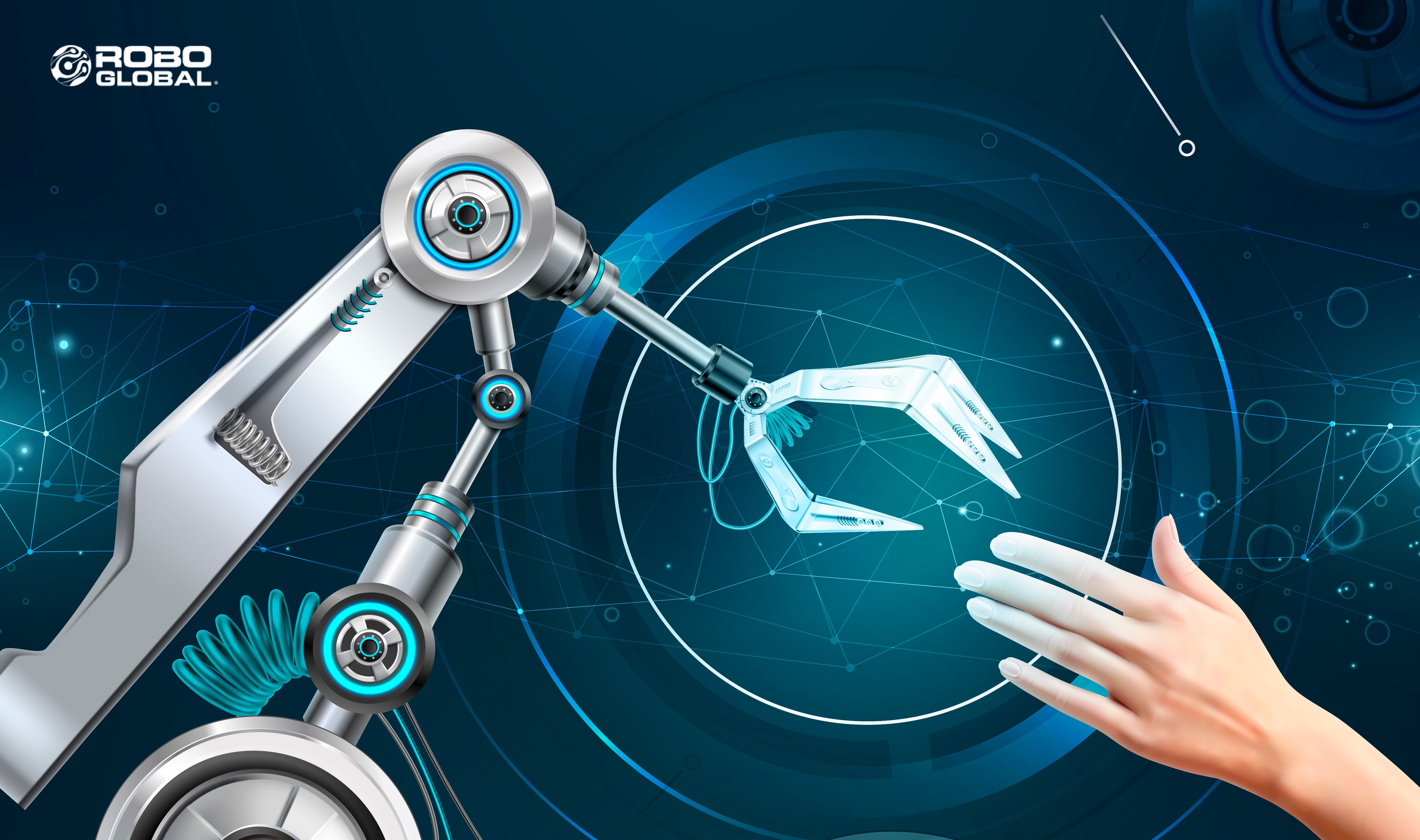By: Richard Lightbound, ROBO Global CEO, EMEA
It wouldn’t be dramatic to say that in this very moment, disruptive technologies are transforming the trajectory of our society. Sometimes, the idea of robotics, AI, and automation to those on the outside might elicit a knee-jerk reaction that revolves around a fear of the unknown. The reality of the matter is that these technologies are stepping into our lives to create a safer, smarter, and more sustainable future.
Manufacturing robots are aiding in dull, dirty, and dangerous factory tasks. Genomic sequencing is helping to identify the composition of viruses such as COVID-19, which can then be passed to diagnostic companies that develop tests to slow the spread. We’re seeing some warehouses going “dark” at night to save energy when humans go home, with robots continuing with fulfillment. Telehealth providers are enabling remote doctor’s visits to meet urgent medical needs from home to reduce the further spread of infection. Agricultural drones and robots are surveying farms to help maximize land for crops and monitor for potential problem areas. The list goes on and on.
We believe that these incredible applications across the tech landscape are creating sustainable and lasting impacts for both society and investors. Investment exposure to themes such as robotics, AI, and healthcare technology are inherently tied with future-focused sustainability goals, identifying and addressing global challenges.
SUSTAINABLE INVESTING WITHIN DISRUPTIVE TECHNOLOGY
ESG is an increasingly important part of our process. It’s embedded in all our index strategies and portfolio construction methodology. We believe that the benefits and efficiencies from disruptive technology will positively impact many aspects of our business, service, and consumer lives.
- ROBO (Robotics & Automation)
- HTEC (Healthcare Technology & Innovation)
- THNQ (Artificial Intelligence)
In the absence of a benchmark industry classification system for identifying companies engaged in the three index strategies, we created a ROBO Global Industry Classification System for each index in consultation with industry experts from our strategic advisory board.
Within each strategy, the ROBO Global Industry Classification identifies subsectors of high relevance and high growth that will expand over time. These subsectors are intended to capture companies throughout the “value chain.” As each subsector is discussed, constructed, and managed over time, it must comply with our ESG Policy.
SUSTAINABLE INVESTMENT THEME: ROBOTICS & AUTOMATION

The ROBO Global Robotics & Automation Index (ticker: ROBO) promotes ESG characteristics including, but not limited to, decent work and economic growth, as well as responsible consumption and production. Globally, we are faced with many social challenges, aging populations, healthcare systems at capacity, dangerous pollution levels, overdemand for scarce resources, increasing wage inflation, and safety & health concerns—the list goes on and on. At its core, robotics and automation are about tackling many of these challenges by creating efficiencies and flexibility and assisting human safety and general well-being.
The sustainable investment objective of ROBO is to provide global exposure to best-in-class companies that are leading the global robotics and automation revolution across 12 targeted subsectors that also adhere to our ESG policy, including healthcare, food and agriculture, 3D printing, logistics, and sensing.
Related ROBO Sustainability Developments & Research:
- 3D Printing Community Steps Up to Save Lives
- Robots Are Tackling Our Next Big Global Challenge: Recycling
SUSTAINABLE INVESTMENT THEME: ARTIFICIAL INTELLIGENCE
.png?width=713&name=6640%20Responsibly%20connecting%20and%20empowering%20disciplines%20through%20the%20use%20of%20AI%20%26%20computing%20tools_V001%20(1).png)
The ROBO Global Artificial Intelligence Index (ticker: THNQ) promotes ESG characteristics including, but not limited to, quality education and reduced inequalities. AI technologies offer broad capabilities that can be applied to all industries, profoundly transforming the world around us in ways that are highly beneficial to society.
The sustainable investment objective of THNQ is to provide global exposure to best-in-class companies that are leading the global artificial intelligence revolution across 11 targeted subsectors that also adhere to our ESG policy, including healthcare, e-commerce, network & security, and big data analytics.
Related THNQ Sustainability Developments & Research:
- Crisis Accelerates Re-shaping of Work with Automation & AI
- Artificial Intelligence: The Best Weapon in The War Against Cyber Attacks
SUSTAINABLE INVESTMENT THEME: HEALTHCARE TECHNOLOGY
.png?width=2500&name=6927%20Investing%20in%20Healthcare%20Technology_V001_A%20(1).png)
The ROBO Global Healthcare Technology & Innovation Index (ticker: HTEC) promotes ESG characteristics including, but not limited to, good health and well-being as it looks to long-lasting and large-scale developments for increased efficiency and effectiveness in healthcare—all with patients at the center of innovation.
The sustainable investment objective of HTEC is to provide global exposure to best-in-class companies that are leading the global healthcare technology revolution across 9 targeted subsectors that also adhere to our ESG policy, including diagnostics, robotics, genomics, precision and regenerative medicine, lab automation, instruments, data analytics, and telehealth.
Related HTEC Sustainability Developments & Research:
- Smart Tech Evolutions in Diabetes
- Genomic Advancements Are Advancing Early Cancer Detection
- Healthcare Tech Races to Treat the Coronavirus Outbreak
- Creating a Healthier Tomorrow—In the Lab
About the ROBO Global ESG Policy & Investing in Sustainable Innovation:
We formally introduced our ESG Policy in 2017 and also became a signatory of the Principles for Responsible Investment. We adhere to the Economic Co-operation and Development (OECD) Principles of Corporate Governance. Finally, our ESG policy is applied throughout our research and filtering process, which is applied quarterly and managed by the Industry Classification Committee.
We are committed to maintaining and continuously improving a research and investment process that incorporates ESG aspects. This ESG Policy represents our current approach and is expected to evolve over time.





